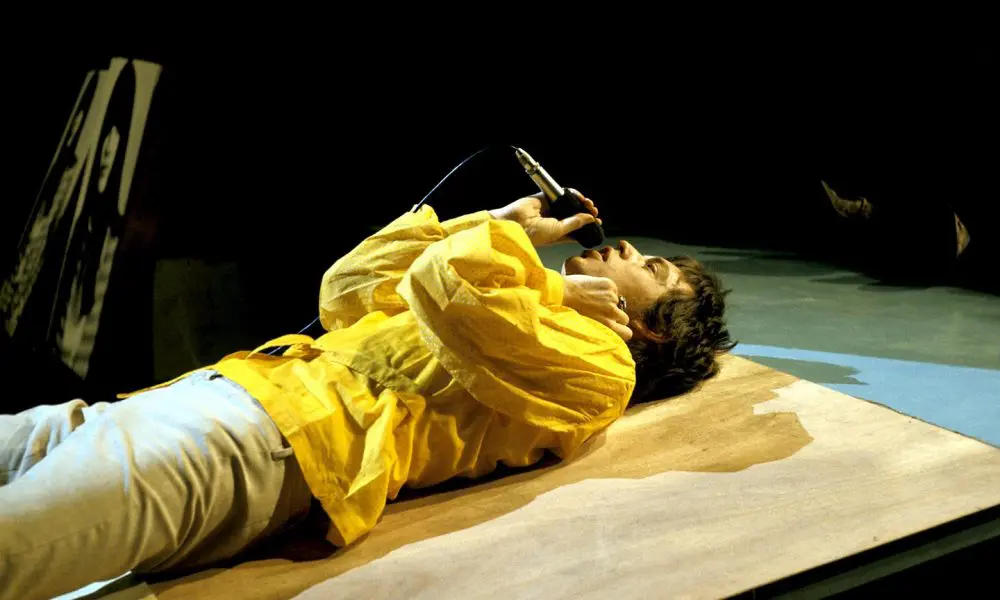‘Paint It Black’: The Story Behind The Rolling Stones Classic
Heavy, thunderous, and full of despair, the song thrills in its psychedelic potency.

“That song was going nowhere,” said The Rolling Stones’ manager and producer Andrew Loog Oldham as he remembered the group toiling in the studio on the freshly written song, “Paint It Black.” “Another 10 minutes,” he’d determined, “and it’ll be time to move on.”
It was the first week of March 1966, and the Stones were in a favorite American studio – RCA in Los Angeles – working with engineer Dave Hassinger to finish their next album, Aftermath.
Listen to The Rolling Stones’ “Paint It Black” now.
Among the songs they were preparing to record was “Paint It Black,” which had been composed by Mick Jagger and Keith Richards while the group were on tour in Australia the previous month. “I wrote the melody,” stated Keith, “he wrote the lyrics.” But in exploring the sonic possibilities of the new, minor key number, the Stones had stalled before fully unlocking its magic. Short on time, they were close to giving up on it completely.
The background
There was a sense of urgency in the studio, but the real pressure was on delivering a new hit single. The Stones had been chart-toppers since the summer of 1964, but it was only a year ago – when “The Last Time” was released in February 1965 – that they’d begun to score with original Jagger/Richards material.
A string of Number Ones followed, and it was a winning streak they did not want to break. However, this current contender was lacking the driving insistency and scowling attitude that had fuelled earlier hits like “(I Can’t Get No) Satisfaction” and “19th Nervous Breakdown,” and now seemed so synonymous with The Rolling Stones.
“Our songs were taking on some kind of edge in the lyrics…” Jagger once explained. “Cynical, nasty, skeptical, rude… The lyrics and the mood of the songs fitted with the kids’ disenchantment with the grown-up world of America, and for a while we seemed to be the only provider, the soundtrack for the rumbling of rebellion, touching on those social nerves.”
A game-changing suggestion
Yet, here they were with an arrangement for “Paint It Black” that neither matched the intensity of its forebears, nor the oppressive themes which its lyrics suggested. “‘Paint It Black’ was just going to be like a beat group number,” Jagger said. “It was just one big joke.”
Then, after listening to the last playback, Bill Wyman had an unusual idea. “I suggested Hammond organ pedals,” the bassist said. “I lay on the floor under the organ and played a second bass riff on the pedals, with my fists, at double-time.”
The effect immediately fattened the song’s bottom end, as Wyman had intended, but more importantly, it suddenly eschewed its perceived direction. By inadvertently stirring in evocative, Turkish flavors, Wyman had sent the song careering into territory far more exotic than the Stones had hitherto adventured. “That’s it!” thought an exhilarated Oldham. “I’d heard the sound and movement we needed, the whimsy that spelt ‘radio.’”
The finishing touch
In pursuing this curious musical detour, guitarist Brian Jones was set to add extra color – but not with his usual six strings. “Brian had pretty much given up on the guitar by then,” stated Keith Richards. “If there was [another] instrument around, he had to be able to get something out of it, just because it was there.”
Brian had floundered in the power struggle that pitted him against his songwriting colleagues. The distance was exacerbated by his unreliability, a by-product of his disillusionment and increasing drug use. Unable to write his own songs, he began to draw pleasure in embellishing Mick and Keith’s tracks beyond the threshold of conventional guitar melodies. An accomplished saxophonist, Brian would enrich the musical palette of Aftermath with dulcimers, marimbas, kotos, and – in the case of “Paint It Black” – a sitar.
Back in December 1965, Brian had heard George Harrison playing the sitar on “Norwegian Wood” when The Beatles released their Rubber Soul album. A week later, during the Stones’ first sessions for Aftermath in RCA, the group’s pianist/road manager Ian Stewart procured Brian a sitar of his own. Soon, a chance meeting with a sitar virtuoso named Harihar Rao would lead to Brian studying under his tutelage. “I met him in a club in New York,” Brian said. “Hari taught me how to play [the sitar]. He studied under Ravi Shankar for 12 years, yet he still considers himself a pupil; these people dedicate their lives to the instrument.”
Though he had by no means mastered the sitar, Brian had at least realized how its sound could work within the Stones’ music. “I love the instrument,” he explained, “it gives you a new range if you use an instrument like that. It has completely different principles from the guitar and opens up new fields for a group in harmonics and everything.”
Thus, as the Stones began to unravel the Eastern qualities that “Paint It Black” was conveying, Brian put his sitar to eloquent use, picking out the vocal melody in the verses and furnishing the song with its unique and portentous intro riff. “It was more than a decorative effect,” Oldham proclaimed. “Sometimes Brian pulled the whole record together.”
The lyrics
Now backed by this malevolent milieu, Jagger’s lyrics – which would have been far too bleak for a straightforward pop song – are perfectly pertinent. It’s a song about bereavement and the despondency one feels during that process.
In it, Mick has suffered a sudden loss, and can’t bear that life must go on without his lover – his mourning has veiled his appreciation for the vibrant colors around him (“I want them to turn black”), and can’t even consider anyone else in his present state; “I have to turn my head,” he sings, “until my darkness goes.”
Much like Charlie Watts’ hammering toms, there is little respite in Mick’s grief, and as the song rides out, he seems to sink deeper and deeper into his suffering. “It’s not easy facing up,” he laments, “when your whole world is black.”
The release and legacy
Arriving a month behind Aftermath, “Paint It Black” was released on May 7th in the US, and the 13th in the UK, rising to the top of the charts in both countries. It would be two years before The Rolling Stones would have another Number One single.
In the meantime, the impact of “Paint It Black” was being felt – in many ways. The single, which bore a label crediting the song to Jagger/Richards, rankled the band, who felt its improvisational evolution was a group effort.
But it was Brian that would come to symbolize “Paint It Black”’s public perception – in the United States, at least. When the band performed the song live on The Ed Sullivan Show that September, it was Brian – sitting cross-legged, isolated from the group, all dressed in white, his golden hair radiant, blissfully plucking his imposing sitar – that would appear, to all America, as the glistening, ethereal embodiment of the Stones’ pioneering psych-pop adventuring.
Over in Vietnam, meanwhile, the foreboding energy of “Paint It Black” was picked up by the American troops, who identified with the song’s implicit fury and despair while valiantly trying to survive in an increasingly horrific and pointless war.
With pounding drums striking underneath the sitar’s unsettling drone, “Paint It Black” was the sound of danger: a chilling harbinger of imminent dread. The song’s graphic expressiveness has been aptly employed on screen as a depiction of the diabolic – most notably at the close of Stanley Kubrick’s harrowing Vietnam drama, Full Metal Jacket. “It’s definitely on a different curve to anything else,” Keith accepted.
Distorted and disquieting, “Paint It Black” may well be the aural equivalent of that most feared hindrance to the mind-expanding experience: a bad trip. “That was the time of lots of acid,” Jagger would concede. “It’s like the beginnings of miserable psychedelia. That’s what The Rolling Stones started – maybe we should have a revival of that.”














